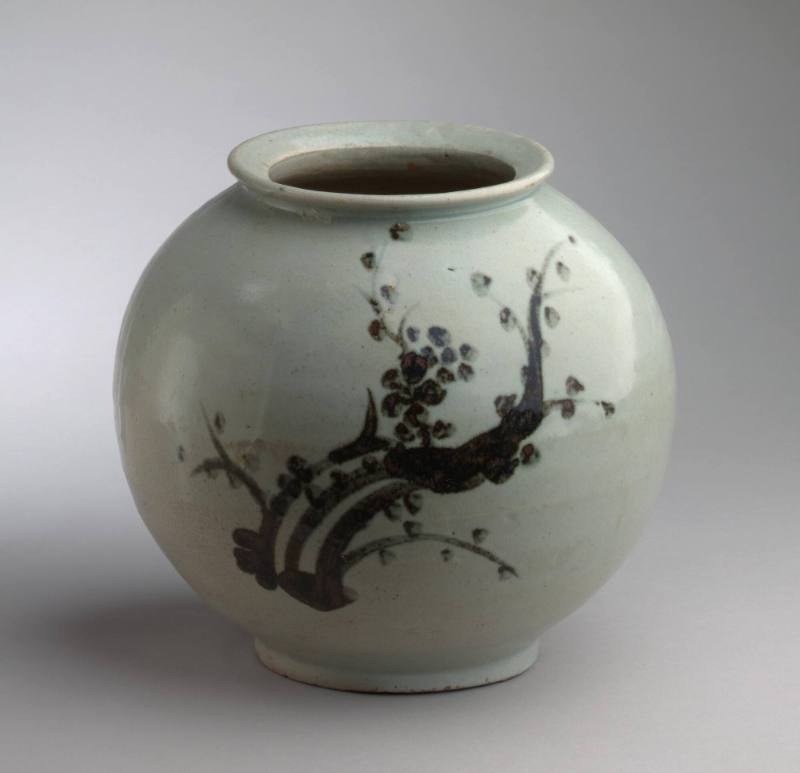

Object Details
Culture
Manteno (Ecuador)
Date
AD 600-1500
Medium
Earthenware
Dimensions
7 11/16 x 5 5/16 inches (19.5 x 13.5 cm)
Credit Line
Gift of Thomas Carroll, PhD 1951
Object
Number
2006.070.276
BRIEF DESCRIPTIONThis ceramic Manteño vessel features an effigy of a man masturbating on the top. A(…)
BRIEF DESCRIPTIONThis ceramic Manteño vessel features an effigy of a man masturbating on the top. An effigy is a sculpture made in the shape of a person or an animal. This vessel also functions as a whistle pot.WHERE WAS IT MADE?This was made in the coastal region of what is now Ecuador.HOW WAS IT MADE?The vessel was hand-built with the coiling method. In this method, a base is made by shaping clay into a flat disc. Then hand formed coils of clay, like ropes, are successively added to one another, building up the walls of the bowl. A tool such as a wooden paddle is used to smooth the sides both inside and out, leaving no trace of the coils. The figure on top was hand modeled separately. Then the entire vessel was burnished before it was fired in an earthen pit. The color of “blackware” ceramic is achieved in the firing process. While firing ceramics in a pit fire, the fire is smothered just enough to remove excess oxygen while still burning hot enough to fire the pottery. Unlike ceramics fired with plenty of oxygen, which may range in color from creamy buff to orange or red, ceramics fired in a “reducing” atmosphere will be gray or black in color. In this case, the clay turned a shade of reddish-brown, and so may have been fired imperfectly.HOW WAS IT USED?This vessel functioned as a whistle pot. There is a large opening in the back of head—this is the blow-hole for the whistle. The exit hole is at the anus.Although the specific use of whistling pots is unknown, we do know that sounds and music were important in the lives of pre-Columbian people, based on the many representations of musicians playing the panpipes and because of the large number of surviving ceramic whistles, whistling pots, and (more rarely) flutes. The sounds produced by such instruments were used to open connections to the spirit world. Music served to invoke benign guardian spirits. After the Conquest, Europeans attempted to ban musical instruments such as flutes in order to suppress such contact with spirits.WHY DOES IT LOOK LIKE THIS?The depiction of sexual acts on pottery is not unusual in pre-Columbian America. Contemporary Manteño vessels like this one are blackware Chimú bottles that represent a woman masturbating her male partner as well as images of actual coitus. In this example, the figure may be masturbating to achieve a form of ecstasy: not just personal pleasure, but communication with the divine.Notice that the male figure is naked except for his jewelry and a helmet-shaped headdress incised with triangular decorative motifs. The shape of the helmet/headdress may indicate cranial deformation. Manipulation of head shapes was common throughout Mesoamerica and South America in pre-Columbian times. Human head shapes can be deformed or changed in infancy, since the skull is relatively soft. Common pre-Columbian head shapes were produced by tightly circling the baby’s head with cloths (to produce an annular or tall rounded shape), or by tying boards or other hard objects to the back of the head and/or the forehead (to produce a broad, flat shape). Differences in head shape served to mark geographic origins or group affiliation. In the Andes today, hats are used in a similar way, with each community having characteristic headgear distinct from those worn in neighboring areas.ABOUT THE MANTEÑO CULTURE:The Manteño culture was centered along the semiarid Ecuadorian coast north of the Bahía de Caráquez. The Manteño were an agricultural people who cultivated maize, manioc (yuca or tapioca), peanuts, tobacco, cotton, potatoes, peppers, avocados, and squash. Local chiefs of high rank living in semi-urban centers governed the people. The Manteño navigated incredible distances to maintain extensive commercial exchange networks with both Mesoamerica to the north and Peru to the south. Manteño pottery is typically burnished blackware, fired in a “reducing” (low-oxygen) atmosphere, with finely incised line decorations. Figures of impressive nude male figures with large nose-rings, often seated on chiefly benches, are hallmarks of Manteño art and may reflect the increasing power wielded by chiefs during the Integration Period (AD 500-1500). Manteño artisans also excelled at metalworking, creating personal adornments such as earrings and nose rings. Animals such as the puma or jaguar, deer, snake, and caiman were considered sacred, and were sacrificed to the gods as well as featured in artwork. The Manteño people (known as the Huancavilcas to the early Spanish) fell under the domination of the Incas near the end of the pre-Columbian period.












